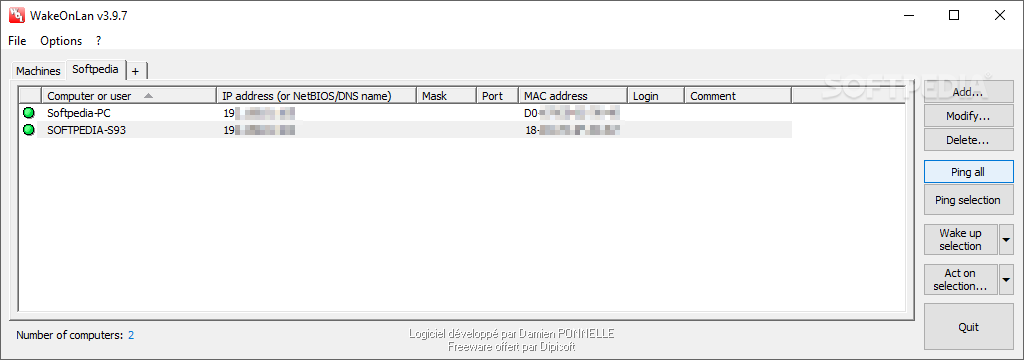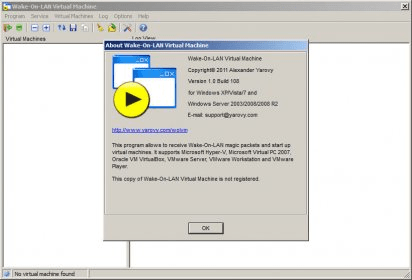

- #Virtualbox machine wakeonlan install#
- #Virtualbox machine wakeonlan code#
- #Virtualbox machine wakeonlan windows#
I installed PHP and MySQL manually the first time around, but when I found the Web Platform Installer, I reinstalled both of them through that.
#Virtualbox machine wakeonlan install#
While it’s possible to install MySQL and PHP manually, you’re better off using the Web Platform Installer to install them so you know they are set up correctly. When you open the Web Platform Installer for the first time you’ll be greeted by a bunch of stuff you can install that you probably don’t care much about, but do a search for WordPress and you’ll get an option to install WordPress.īefore you install WordPress, though, you can add some of the other components we’ll need for a WordPress site.

The Web Platform Installer is a download, if your machine doesn’t already have it, and it becomes just another icon in the Control Panel-like interface you get for each site you create in the IIS Manager.
#Virtualbox machine wakeonlan code#
One opaque error code reads like every other opaque error code and if you don’t know what you’re doing it’s a lot to jump into. They’re also extremely hard to troubleshoot. They are simple xml files, but they need to be set up just so and when you’re doing more complex things on a WordPress site (like rewrite rules), you’re bound to run into issues. If no web.config file exists, the entire site blows up.Īnd web.config files are really tetchy. htaccess file on an Apache server doesn’t exist, the Apache-based site still works. htaccess file on an Apache server–except that if an. The first thing I had to learn the hard way was that there was this thing called a web.config file which is a little like an. I thought there’d be no issue whatsoever just downloading the WordPress software, extracting it, and setting up a site in the built-in IIS Manager tool.
#Virtualbox machine wakeonlan windows#
Now, your Windows server will work great if the type of site you’re building is an ASP.NET site. That’s where you’ll be living for most of the time you will be setting up IIS.

Once you have IIS installed, you’ll be able to go to the Tools dropdown in Server Manager and select Internet Information Services (IIS) Manager. To do this, you’ll need to go to Manage → Add Roles and Features. That’s something that can be added through the Server Manager program that you’ll have a shortcut for in your Start bar. Out of the box, your new Windows server won’t come with IIS installed. However, since it’s Windows, we don’t actually want to do that just yet… Step Two: Set up your Windows Environment At this point, you could vagrant up and start up your machine. That downloads the box (which will probably take more than an hour, so grab a book) and sets up your initial Vagrantfile. Once I knew what box I was using, I could initialize my new Vagrant server: vagrant init lmayorga1980/windows-2012r2 The one I finally went with was a Windows 2012 Server image.

The trick was in the search terms–the search functionality isn’t great. I looked, couldn’t find a Windows server, looked again, and finally found something. You can find a whole repository of box images at. The first thing I needed to do was get a VirtualBox image. At any rate, this method and this box works for me and I’m actively using it as a development environment. It is, by no means, the best solution, and if you know of ways to improve the setup–particularly in syncing files between the two different filesystems–I’d be interested to hear them in the comments. What follows is how I have my local IIS Vagrant WordPress machine working. When I couldn’t find any answers on Google, I tried cobbling together what I could to build my own. Surely someone has tried building on a virtualized Windows machine using Vagrant on OSX. When no response was forthcoming, I took to Google. My goal was to stick with Vagrant, somehow, to allow changes I make on my host to be reflected on the guest and then be able to see those changes in a browser. Your local machine’s filesystem (the “host” environment) can interact natively with the emulated operating system (the “guest” environment). Vagrant is great because you can have different boxes emulating different environments. We do a lot of Microsoft work maybe someone had a recipe or a Vagrant box I could use. In this case, however, I needed the environment to be specifically Windows-based, because the plugin I was planning on building was going to make use of COM functions to pull in and execute Visual Basic scripts that just wouldn’t run on anything other than Windows.įirst, I asked my fellow devs. Many things (like communicating with a MS SQL server) can be emulated or replicated on a *nix environment, in which case the Vagrant workflow I’ve spent a lot of time and energy switching over to would work fine. …And lo! It came to pass that I needed to set up a local environment built on IIS.


 0 kommentar(er)
0 kommentar(er)
